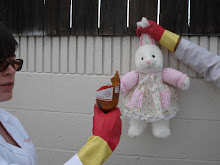 When you have ridges, you have hot vents. Remember that ridges are the places where new crust is being formed as magma oozes up to the surface. Hot vents are those fun sea floor features we see on nature programs with all sorts of weird lobsters and tube worms growing around them. A sidennote here: lots of those critters (crabs, shrimps, lobsters) have no pigment because, well, what would be the advantage of having color in pitch blackness? When the submersibles get down there to take all those pretty pictures we see in magazines and on the Discovery channel, they blast the area with flood lights. All that light shocks the shit out of those critters and usually a ton of them die as a result. But before you get all worked up about this just remember that shrimps and lobsters and crabs are the bugs of the sea, so you shouldn’t feel any worse than you do squashing a cockroach. There, feel better hippy?
When you have ridges, you have hot vents. Remember that ridges are the places where new crust is being formed as magma oozes up to the surface. Hot vents are those fun sea floor features we see on nature programs with all sorts of weird lobsters and tube worms growing around them. A sidennote here: lots of those critters (crabs, shrimps, lobsters) have no pigment because, well, what would be the advantage of having color in pitch blackness? When the submersibles get down there to take all those pretty pictures we see in magazines and on the Discovery channel, they blast the area with flood lights. All that light shocks the shit out of those critters and usually a ton of them die as a result. But before you get all worked up about this just remember that shrimps and lobsters and crabs are the bugs of the sea, so you shouldn’t feel any worse than you do squashing a cockroach. There, feel better hippy?Moving on, all that hydrothermal activity leaves its mark on the surrounding water. One way to tell if you’ve got hydrothermal influence is by measuring 3He in the seawater. 3He is a non-radioactive isotope of Helium with 2 protons and 1 neutron. There is a shitload of it in the Earth’s mantle and it’s thought to have been trapped there as the Earth formed from hunks of spacerock mashing together. 3He is released in places where magma extrudes, like sea-floor ridges and hotspots (ie: Hawaii). Up in the North Pacific we indeed have a “plume” of 3He that extends from the Juan de Fuca ridge all the way into the mid-Pacific.
 So what’s the big deal? Well, by sussing out the location of the plume we have an idea of how the water is moving around at this depth in this part of the world. The plume reaches out to the southwest and exists at a depth of 2000m. There must be some sort of current at 2000m that carries this 3He southwards and away from North America. That’s a start.
So what’s the big deal? Well, by sussing out the location of the plume we have an idea of how the water is moving around at this depth in this part of the world. The plume reaches out to the southwest and exists at a depth of 2000m. There must be some sort of current at 2000m that carries this 3He southwards and away from North America. That’s a start.For me, I’m interested in understanding this plume of 3He because it coincides with the plume of silica my advisor and I are so interested in. Remember that silica is an ocean nutrient and can be pumped into bottom waters via hydrothermal sources. In the North Pacific we find 3He coinciding with lots of silica, but only in the northern part of the plumes. Once everything reaches the mid-Pacific the two plumes diverge: the helium plume stays a little north of the silica plume. So the question is: if these guys (both the 3He and the silica) are being pumped out of the Juan de Fuca ridged at the same time, at the same temperature, with the same water properties, why aren’t they sticking together as they get carried out into the Pacific? The short answer is that the silica isn't hydrothermal. The long answer will be avalible in dissertation form, and only God knows when.


1 comment:
Oi, achei teu blog pelo google tá bem interessante gostei desse post. Quando der dá uma passada pelo meu blog, é sobre camisetas personalizadas, mostra passo a passo como criar uma camiseta personalizada bem maneira. Se você quiser linkar meu blog no seu eu ficaria agradecido, até mais e sucesso.(If you speak English can see the version in English of the Camiseta Personalizada.If he will be possible add my blog in your blogroll I thankful, bye friend).
Post a Comment